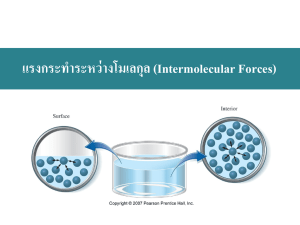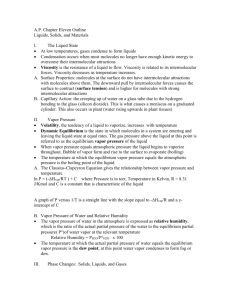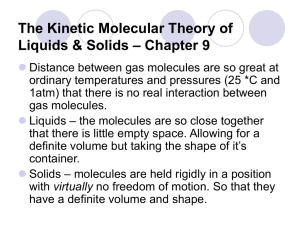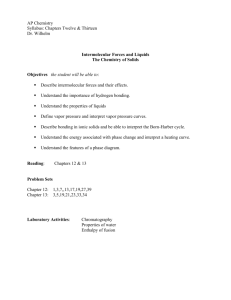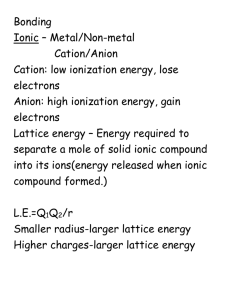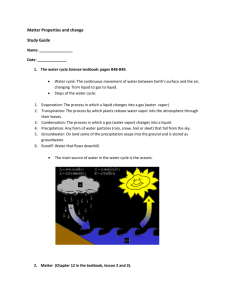Chapter 10 – Liquids and Solids AP Chemistry Goals 1. Differentiate
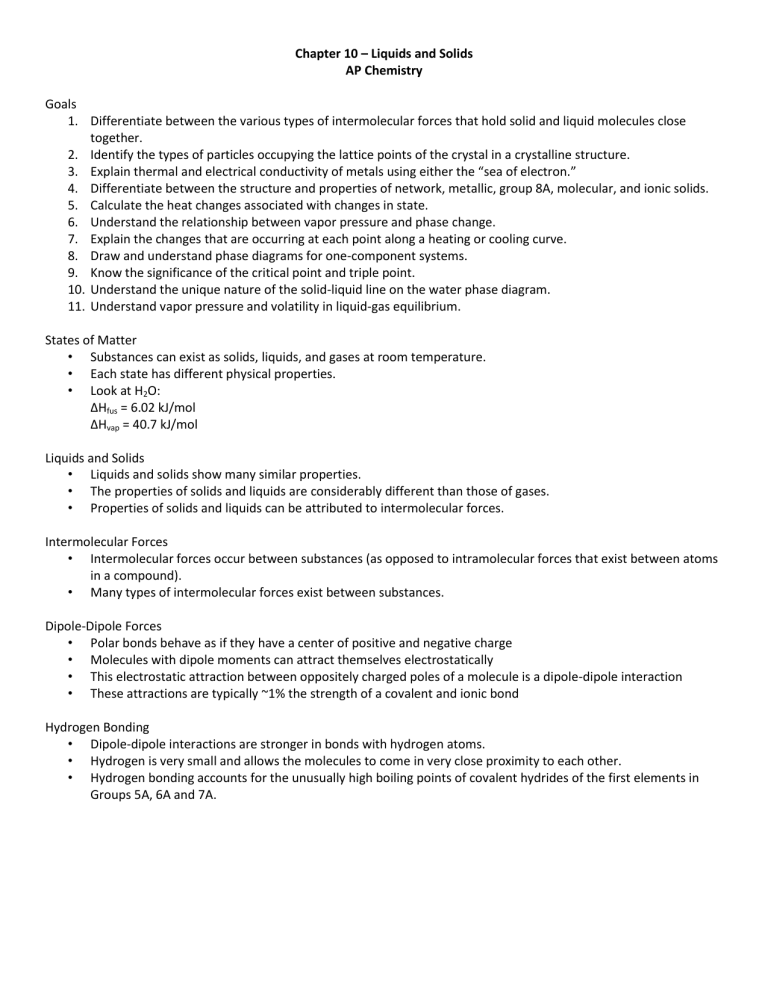
Chapter 10 – Liquids and Solids
AP Chemistry
Goals
1.
Differentiate between the various types of intermolecular forces that hold solid and liquid molecules close together.
2.
Identify the types of particles occupying the lattice points of the crystal in a crystalline structure.
3.
Explain thermal and electrical conductivity of metals using either the “sea of electron.”
4.
Differentiate between the structure and properties of network, metallic, group 8A, molecular, and ionic solids.
5.
Calculate the heat changes associated with changes in state.
6.
Understand the relationship between vapor pressure and phase change.
7.
Explain the changes that are occurring at each point along a heating or cooling curve.
8.
Draw and understand phase diagrams for one-component systems.
9.
Know the significance of the critical point and triple point.
10.
Understand the unique nature of the solid-liquid line on the water phase diagram.
11.
Understand vapor pressure and volatility in liquid-gas equilibrium.
States of Matter
• Substances can exist as solids, liquids, and gases at room temperature.
• Each state has different physical properties.
• Look at H
2
O:
ΔH fus
= 6.02 kJ/mol
ΔH vap
= 40.7 kJ/mol
Liquids and Solids
• Liquids and solids show many similar properties.
• The properties of solids and liquids are considerably different than those of gases.
• Properties of solids and liquids can be attributed to intermolecular forces.
Intermolecular Forces
• Intermolecular forces occur between substances (as opposed to intramolecular forces that exist between atoms in a compound).
• Many types of intermolecular forces exist between substances.
Dipole-Dipole Forces
• Polar bonds behave as if they have a center of positive and negative charge
• Molecules with dipole moments can attract themselves electrostatically
• This electrostatic attraction between oppositely charged poles of a molecule is a dipole-dipole interaction
• These attractions are typically ~1% the strength of a covalent and ionic bond
Hydrogen Bonding
• Dipole-dipole interactions are stronger in bonds with hydrogen atoms.
• Hydrogen is very small and allows the molecules to come in very close proximity to each other.
• Hydrogen bonding accounts for the unusually high boiling points of covalent hydrides of the first elements in
Groups 5A, 6A and 7A.
London Dispersion Forces
• All molecules, whether or not they are polar, exert forces on each other.
• London dispersion forces, often called induced dipole forces, account for nonpolar substances existing in the solid or liquid phase.
• Electrons in an electron cloud can induce a temporary dipole in a neighboring atom.
• This interaction is weak and short-lived but can be quite significant in larger atoms
The Liquid State
• Liquids have:
– Low compressibility
– Lack of rigidity
– High density compared with gases
• Forces of attraction in a liquid depend on where the molecule is in the liquid.
• Molecules on the interior interact with themselves, while molecules on the surface react with the liquids surroundings.
Adhesion vs. Cohesion
• Cohesion – forces among liquids
• Adhesion – forces between molecules and container
• Meniscus:
– Concave – adhesive forces are stronger than cohesive forces
– Convex – adhesive forces are weaker than cohesive forces
Surface Tension
• Surface tension – resistance of a liquid to increase surface area
• Polar molecules tend to form a concave meniscus when placed in a glass tube.
• Nonpolar liquids like mercury form a convex meniscus in a glass tube.
Capillary Action
• Capillary action – spontaneous rising of a liquid in a tube
• Exhibited by polar molecules that have an attraction to the capillary tube.
Viscosity
• Viscosity – measurement of a liquid’s resistance to flow
• Larger molecules exhibit higher viscosity
Introduction to Structure and Types of Solids
• Two main types of solid structures
• Crystalline solids – highly ordered arrangement of components (ionic salts)
• Amorphous solids – considerable disorder in their structure (glass)
Crystalline Solids
• Lattice:
– 3-D system of points (atoms, molecules, and ions)
• Unit Cell:
– Smallest repeating unit of a lattice
– Three common unit cells include – simple cubic, body-centered cubic, and face-centered cubic
• Crystalline structures are determined using X-ray diffraction.
Types of Atomic Solids
• Ionic solids – ions at lattice points
• Molecular solids – discrete covalently bonded molecules at lattice points
• Atomic solids – lattice points are elements
– Metallic – delocalized nondirectional covalent bonding
– Network – bond is strong, localized, and directional
– Group 8A – Noble gases held together by London Forces
Metallic Crystal Structures
• Metallic crystal structures follow the closest packing model.
• The closest packing model assumes metal atoms are uniform, hard spheres.
• These spheres then pack together in a manner that most efficiently uses the available space.
Bonding Model for Metals
• Metals are characterized by having:
– High thermal conductivity
– High electrical conductivity
– Malleable
– Ductile
– High melting point
• These properties are a result of the non-directional covalent bonding found in metallic crystals.
Bonding Continued
• Metal ions exist spread out in a closest packed structure with a “sea of electrons” in between them.
• This accounts for a metals ability to be bent and stretched without breaking.
• It is difficult to separate metal atoms, but easy to move them.
• Mobile electrons can also conduct heat and electricity
Network Atomic Solids
• Large molecules contain strong directional bonds.
• Do not efficiently conduct heat or electricity.
Carbon
1.
Diamond – hard colorless, nonconductor, insulator, tetrahedral arrangement with 4 other carbons
2.
Graphite – black, slippery conductor
Layers of six carbon rings (sp
2
hybridized)
Delocalized electrons in pi bonds
Strong bonding within the layers, but weak bonding between them
Silicon
• Silicon is to geology as carbon is to biology. Different from carbon compound bonding although they are in the same group.
– Carbon makes long C-C chains while silicon makes Si-O chains
• Silica - SiO
2
is the fundamental compound
• CO
2
uses sigma and pi bonding, but silicon is too large for that. Silicon satisfies its octet by forming single bonds with four oxygen atoms (quartz).
• When cooled quickly, silica compounds can form amorphous glass.
Molecular Solids
• Network solids – atoms in lattice positions act as one giant molecule
• Some have discrete molecules at lattice points (H
2
O, CO
2
, S
8
, P
4
). Parts of structure have intramolecular attraction, but parts are held together through intermolecular attraction.
Ionic Solids
• Stable, high-melting substances held together by strong electrostatic forces between oppositely charged ions.
Types and Properties of Solids
Type of Solid:
Structural Unit:
Type of Bonding
Network
Atom
Directional covalent bonds
Metallic
Atom
Nondirectional covalent bonds
Group 8A
Atom
London dispersion forces
Molecular
Molecule
Polar:
Dipole-dipole
Nonpolar: London dispersion
Ionic
Ion
Ionic
Typical
Properties:
Hard, high melting point, insulator
Wide range of hardness and melting points,
Conductor
Silver, iron, brass
Very low melting Soft, low melting points, insulator
Hard, high melting point, insulator
Examples: Diamond Argon (s) Water (s),
Dry Ice (s)
Sodium chloride
Changes in State
• The state of matter a substance exists in depends on its environment.
• Three states of matter:
– Solid
– Liquid
– Gas
Vapor
• Vaporization (evaporation) is the endothermic process in which a liquid becomes a gas.
• Heat of Vaporization:
– Energy needed to vaporize 1 mole of liquid
– Water has a high ΔH vap
= 40.7 kJ/mol, meaning it can absorb a lot of heat
Vapor Pressure
• Vapor – gas phase of a substance that exists as a liquid at 25 o
C and 1 atm.
• There is a dynamic equilibrium between a liquid and its vapor.
• A liquid/vapor system has reached equilibrium when the rate at which liquid molecules become vapor and vapor molecules become liquid is the same.
• Vapor pressure – pressure exerted by vapor at equilibrium
Measuring Vapor Pressure
• Vapor pressure can be measured using a simple barometer.
• P atmosphere
= P vapor
+ P
Hg column
• P vapor
= P atmosphere
- P
Hg column
• Vapor pressure of a substance increases with temperature.
Graphical Analysis of Vapor Pressure vs. Temperature
• A plot of vapor pressure vs. temperature is nonlinear.
• ln(P vap
) vs. 1/T(K) is linear and follows y = m x + b
• y = lnP vap
, x = 1/T, m = -ΔH vap
/R, C = a constant characteristic of the liquid, R = 8.314 J/(Kmol)
• Clausius-Clapeyron Equation: lnP vap
= -(ΔH vap
/R)(1/T) + C or ln(P vap,T1
/P vap,T2
) = (ΔH vap
/R)(1/T
2
– 1/T
1
)
• This relationship is useful for determining either enthalpies of vaporization from vapor pressure measurements or vapor pressures at different temperatures.
Example
• The boiling point of acetone at 760. torr is 56.5
o
C. At an elevation of 5,300 ft the atmospheric pressure is 630. torr. What would be the boiling point of acetone (ΔH = 30.2 kJ/mol) at this elevation? What would be the vapor pressure of acetone at 25 o
C at this elevation?
Sublimation
• A solid to gas phase change is called sublimation (opposite is called deposition).
• This occurs because solids have vapor pressures.
Changes of State
• Changes in state can be represented using a heating curve (a plot of temperature vs. time).
• Solid↔Liquid = Heat of Fusion (ΔH fus
)
Point at which solid and liquid have identical vapor pressures
• Liquid↔Gas = Heat of Vaporization (ΔH vap
)
Point at which liquid and vapor have the same vapor pressure under conditions in which the system is under a constant pressure of 1 atm.
• ΔH vap
> ΔH fus
Heating Curves
• When heating or cooling a substance at a constant rate q = mcΔT.
• At phase boundaries, the temperature remains constant until the entire substance has changed state. Only then can the substance be heated or cooled.
• Heating Curve for H
2
O
Example
• A beaker contains 50.0 g of water and 25.0 g of ice, both at 0.0
o raise the final temperature of the water to 22.0
o
C. How many kilojoules of energy is need to
C? The specific heat capacity of liquid water is 4.18J/g o
C and the enthalpy of fusion for ice is 6.02 kJ/mol.
Phase Diagrams
• Phase diagrams represent the phases of a substance as a function of temperature and pressure.
• Phase diagrams represent a substance in a closed system.
• Critical Temperature – temperature above which no applied pressure can liquefy a vapor
• Critical Pressure – pressure required to produce liquefaction at the critical temperature
• Critical Point – point at which the critical temperature and pressure are achieved
• Triple Point – point at which the vapor pressure of the solid, liquid, and gaseous phases are in equal
Normal Melting and Boiling Points
• Normal Melting Point – temperature at which the solid and liquid states have the same vapor pressure under conditions where the total pressure is 1 atmosphere
• Normal Boiling Point – temperature at which the vapor pressure of a liquid is exactly one atmosphere

